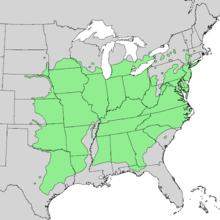| Eastern black walnut | |
|---|---|

| |
| Leaves and fruit | |
| Scientific classification | |
| Kingdom: | Plantae |
| Clade: | Tracheophytes |
| Clade: | Angiosperms |
| Clade: | Eudicots |
| Clade: | Rosids |
| Order: | Fagales |
| Family: | Juglandaceae |
| Genus: | Juglans |
| Section: | Juglans sect. Rhysocaryon |
| Species: | J. nigra
|
| Binomial name | |
| Juglans nigra | |

| |
| Natural range | |
Juglans nigra, the eastern American black walnut, is a species of deciduous tree in the walnut family, Juglandaceae, native to North America. It grows mostly in riparian zones, from southern Ontario, west to southeast South Dakota, south to Georgia, northern Florida and southwest to central Texas. Wild trees in the upper Ottawa Valley may be an isolated native population or may have derived from planted trees.
Black walnut is an important tree commercially, as the wood is a deep brown color and easily worked. Walnut seeds (nuts) are cultivated for their distinctive and desirable taste. Walnut trees are grown for lumber and food, and processors have found additional markets for even the tough outer hulls by finely grinding them for use in abrasive cleansers, exfoliating cosmetics, and the like.[2] Many cultivars have been developed for improved quality wood or nuts. In 2017, the U.S. Department of Agriculture (USDA) valued United States walnut timber at $530 billion, and the Missouri Department of Conservation has stated that it is the most valuable timber raised in Missouri.[2]
Black walnut is susceptible to thousand cankers disease, which provoked a decline of walnut trees in some regions.
Black walnut is anecdotally known for being allelopathic, which means that it releases chemicals from its roots and other tissues that may harm other organisms and give the tree a competitive advantage. There is not, however, solid scientific consensus that allelopathic chemicals in black walnut are the primary source of its competitive growth in an area.[3]
- ^ Stritch, L. (2018). "Juglans nigra". IUCN Red List of Threatened Species. 2018: e.T62019712A62019714. doi:10.2305/IUCN.UK.2018-1.RLTS.T62019712A62019714.en. Retrieved 19 November 2021.
- ^ a b Cite error: The named reference
:2was invoked but never defined (see the help page). - ^ Chalker-Scott, Linda. Do black walnut trees have allelopathic effects on other plants?. rex.libraries.wsu.edu (Report). Home Garden Series. hdl:2376/14212. Archived from the original on 19 September 2022. Retrieved 2022-09-18.
